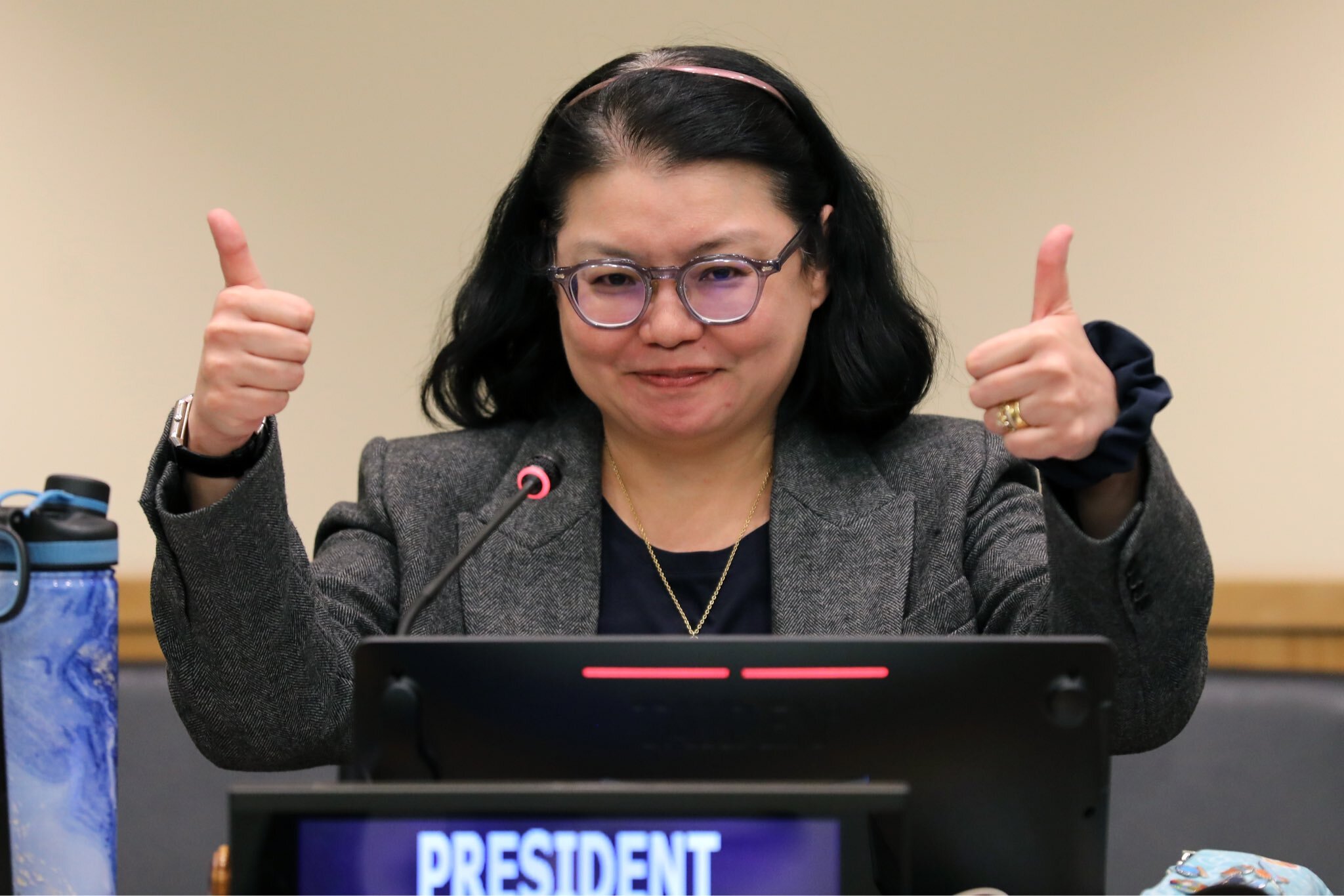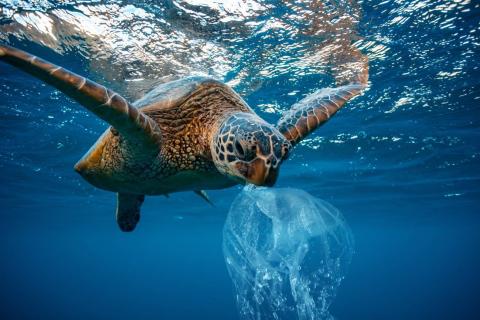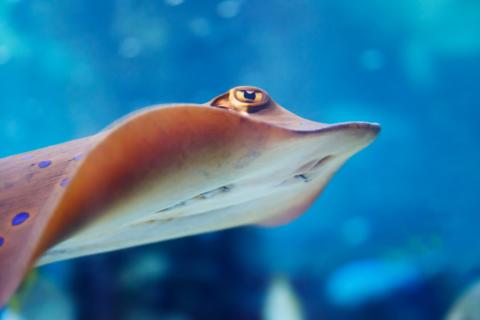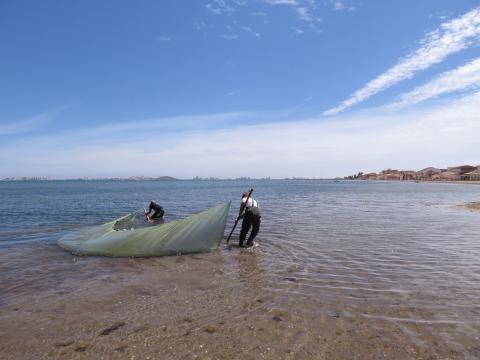Reactions: Oceans Treaty goes ahead after more than 15 years of negotiations
The deadline passed and after two marathon nights of meetings, the delegations of the UN member states have managed to reach an agreement to make the so-called Oceans Treaty - or BBNJ Treaty, Biodiversity Beyond National Jurisdiction - a reality. New York City has seen the fifth session of this conference bear fruit with an agreement on the wording of the text, seventeen years after the talks began and with negotiations stalled last August due to a lack of agreement. The Treaty aims to protect and regulate the use of areas beyond national jurisdiction, which account for more than 60% of the oceans, or almost half of the planet. Marine genetic resources and how to share these benefits has been one of the main stumbling blocks.

Conference president Rena Lee announcing the agreement. Author: David Cooper.
Carlos García - tratado océanos EN
Carlos García-Soto
Researcher at the Spanish Institute of Oceanography (IEO-CSIC), president of the European Centre for Marine Science and Technology Information (EurOcean) and has been coordinator of the World Ocean Report (2021-2022, United Nations)
This is a historic agreement that comes after 17 long years of discussions by States at the United Nations. This treaty will allow us to implement marine protected areas in international waters and thus protect marine biodiversity, meeting the so-called 30x30 target (protection of 30% of the ocean by 2030), the minimum necessary to reverse the dramatic loss of marine biodiversity.
The treaty will enable us to conduct environmental impact assessments in regions beyond international jurisdiction, which account for two-thirds of the entire ocean. Maritime transport, for example, accounts for 90% by volume of world trade. The treaty will also allow us to organise the exploitation of marine genetic resources in such a way that the benefits accrue to all countries, which are collectively their moral owners.
And finally, this international agreement will allow us to fulfil the eternal promise of capacity building for developing countries, including the transfer of marine technology from more developed countries. This transfer will allow them, for example, to do their own research on marine genetic resources and their own environmental impact assessments.
It has been a long 17 years and the treaty has room for improvement, but to quote Noam Chomsky, when the choices are to abandon hope, ensuring that the worst will happen, or to seize the opportunities that exist and contribute to a better world, the choice is not a difficult one. Today we have seen the best side of the United Nations.
Guillermo Ortuño - tratado océanos EN
Guillermo Ortuño Crespo
Co-Lead of the IUCN WCPA High Seas Specialist Group
At 9:40 pm local New York time, and after more than 24 hours of additional negotiations, the BBNJ Treaty chair called all participants together to announce the end of the negotiations as the parties had reached agreement on the text of the new treaty.
Although the final text has not yet been published, all previous drafts point to a treaty where consensus prevailed to perfection. Although it is far from the treaty that many members of the scientific community and civil society would have wished for and that the planet's biodiversity deserves, the new text is a step in the right direction towards the conservation and sustainable use of nature on no less than 46% of the Earth's surface.
The treaty, which is divided into four main sections, creates, for the first time, mechanisms for the creation of marine protected areas in international waters. Once the text is signed, the complicated process of ratification and implementation will begin, which will face, among others, the industrial fleets of several countries, including Spain's, which have enjoyed several decades of unlimited environmental impact in international waters. The section of the treaty causing much of the delay has to do with the redistribution of benefits from the international genetic heritage from which a few countries or companies have benefited so far; as it belongs to all of us, any derivative of this genetic material from species on the high seas belongs to all of us, and it is in these terms that the fiercest negotiations of this process have been conducted. Other issues related to national sovereignty and voting modalities were also debated to the end.
After this agreement in principle the work continues, as the text must be polished and translated into the six official UN languages; President Rena Lee made it clear that the content of the text would not be altered in this process. The parties will meet again at a future date for ratification of the treaty.
Carlos Duarte - tratado océanos EN
Carlos M. Duarte
Executive Director of the Global Coral Reef R&D Acceleration Platform and holder of the Tarek Ahmed Juffali Research Chair in Red Sea Ecology at King Abdullah University of Science and Technology (KAUST) in Saudi Arabia
The treaty reached focuses on the protection of 30% of international ocean waters, which will implement the December 2022 COP15 resolution of the Convention on Biological Diversity in that regard. In addition, the treaty includes provisions for any use of sub-seabed resources to be subject to a prior environmental impact study, which is not a moratorium on seabed mining activity as some, myself included, wished, but at least it does not leave this ecosystem completely unprotected as it has been until now.
Where the agreement seems to be even more vague, in the absence of reading the text, is in the sharing of economic benefits derived from the ocean's genetic resources, where the treaty seems to contain vagueness, such as that it will be exploited on an equitable basis, without articulating a mechanism to achieve this. A decade ago we published research showing that 10 nations owned 97% of the ocean's genetic resources, with one company, BASF, owning 70% of the patents. In our work we already pointed to a mechanism for resource sharing, which is more about sharing and capacity building than monetary compensation. This will have to wait, perhaps another decade. In short, a step forward but not with the necessary momentum.
Ángel Borja - tratado océanos EN
Ángel Borja
Principal Researcher in the area of Environmental Management of Seas and Coasts at AZTI and editor-in-chief of the journal Frontiers in Ocean Sustainability
It can rarely be said that an international treaty is historic, but in this case it is true. After many years of discussion, the treaty on the conservation and sustainable use of marine biodiversity beyond areas under national jurisdiction has been approved. To get an idea of its importance, suffice it to say that these areas occupy 40% of the planet's surface and 64% of the ocean. Until now, these areas were not subject to any regulation, so any country could do whatever it wanted. At least now there are a number of aspects that are regulated:
- Marine genetic resources, which are becoming increasingly important in terms of advances in medicine, food, etc.
- The management and protection of marine areas, which are necessary to achieve the 30% ocean protection target and to help conserve biodiversity and halt its loss, as well as to combat climate change.
- Carrying out environmental impact assessments, necessary for a multitude of growing activities such as the installation of renewable energies, mining operations or the installation of submarine cables.
- The creation and transfer of marine technologies, promoting cooperation between countries to get to know our seas as we know, for example, the Moon.
It is true that there are still aspects that could be improved - for example, fishing is not included in the treaty, it is not clear how some resolutions can be enforced, etc. - but it is a good starting point for achieving the sustainable development goals for 2030.
Carmen Morales - tratado océanos EN
Carmen Morales
Lecturer at the University of Cadiz, researcher at the Institute of Marine Research (INMAR) and Scientists Coalition for an Effective Plastics Treaty
This agreement is a big step towards others that should be taken more forcefully. Habitat degradation, unsustainable resource exploitation, pollution, invasive species and the climate emergency threaten the diversity of life in the ocean and with it, the services it provides us. Today we face global challenges that threaten the health of marine ecosystems, biodiversity and thus our own well-being. Many of these challenges need to be addressed from several angles. The ocean has no gates, no borders. If marine protected areas are created, but anthropogenic pressures on adjacent areas are not reduced, the impact will come. And it will come, and humans will forget, because humans transform the world and, over time, we lose important knowledge about the state of the natural world.
In addition to protected areas, the agreement also pays special attention to the challenge of access to genetic resources and benefit sharing, establishing an access and benefit-sharing mechanism for fair and equitable participation. Key will be the formation of a group of people with the capacity to carry out this mechanism in the most effective and committed way, without giving rise to conflicts of interest.
Special attention is also given to mechanisms for conducting environmental assessments for the sustainable use of resources in areas beyond national jurisdiction, which is key for the present and near future. Another major element is capacity building and transfer of marine technology; it will be important to define concrete mechanisms for efficient implementation. Likewise, it will be necessary to define how the UNCLOS Secretariat will effectively connect with other related bodies (e.g. IOC-UNESCO, IMO, UNEP, among others) that by the nature of their missions can contribute a great deal to the different processes, and not leave it at "possible cooperation".
The agreement recognises the "desire" to protect the marine environment and ensure its responsible use while maintaining the integrity of ecosystems. It would be desirable that, rather than a desire, it should be a commitment.
Nuria Navarro - tratado océanos EN
Nuria Navarro Andrés
Professor and coordinator of the Coastal and Marine Research Group (ZOCOMAR) of the Department of Biology and Geology, Physics and Inorganic Chemistry of the Rey Juan Carlos University
The Oceans Treaty or BBNJ Treaty (Biodiversity Beyond National Jurisdiction) began to be discussed at the United Nations in 2006, to ensure the conservation and sustainable use of marine biodiversity in areas beyond national jurisdiction. After a process of more than 16 years of negotiations without reaching an agreement, it seems that today, at last, the treaty has been agreed.
The oceans produce more than half of the oxygen we breathe, absorb much of the CO2 produced by human activity (thus limiting global warming), feed much of humanity and are home to most of the planet's biodiversity. Despite this, the oceans are highly threatened by climate change, pollution and overexploitation of their resources, and less than 3% are protected.
This treaty for international waters proposes to create a global network of Marine Protected Areas covering 30% of the global ocean by 2030 (30x30 target) and representative of major ecosystems. This would protect habitats and species, reverse biodiversity loss and maintain ecosystem services.
The main stumbling block to reaching consensus, both now and in the past, has been over marine genetic resources, due to how to fairly and equitably share the future benefits of their commercialisation among all states. In the absence of reading the final text, it seems that the agreement is somewhat ambiguous in this respect, and the proposed mechanisms for achieving this are not yet known.
Although there is room for improvement and the treaty still needs to be ratified by all countries, there is no doubt that a very important step has been taken today to protect the oceans and to ensure the conservation and sustainable use of marine biodiversity. Life on Earth depends on the health of the oceans, and we must leave that legacy to our sons and daughters.



